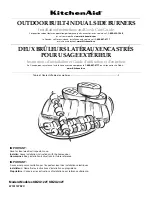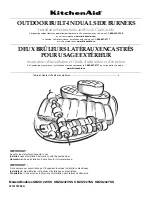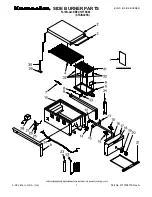
14
Värmebaronen Viking Bio 35
Pellet firing
The burner’s parts in contact with flames are wearing parts
that need replacement as required. To extend the burner’s
service life and maintain good combustion with high
efficiency, the following points should be observed:
• The burner must be adjusted with a flue gas analysis
instrument for the pellet quality used.
• If the quality and/or supplier of pellets is changed,
adjustment must be repeated. Pellets may have different
contents that may affect combustion.
• A draught damper must be fitted between the boiler and
the chimney.
• It is important for the grate to be placed correctly in the
burner pipe.
• Replace damaged parts as soon as possible.
• Follow these instructions.
Pellet quality
Use only wood pellets that meet the requirements
of standard EN 14961-2, class A1.
Minimum pellet requirements under EN 14961-2
Length:
≤
40 mm class A1
Fines content < 3 mm:
≤
1.0 % (by weight)
Calorific value:
≥
4.7 kWh/kg
Ash content:
≤
0.7 %
Total moisture content:
≤
10 % (by weight)
The melting point of the ash should be high, >1350 °C,
as molten (sintered) ash is a problem. Molten ash is very
difficult to remove and increases the cleaning required.
Handling and storing pellets
Wood pellets must be stored in a dry, airy place protected
from the weather.
Handling pellets may entail health hazards. Contact your
pellet supplier for more information on how pellets should
be handled and stored.
Ventilate the store well before entering it and switch off the
feed auger.
Being in an unventilated store may entail a risk of death.
Ensure that children are unable to enter the store.
Naked flames are prohibited near the store.
Combustion
The ash sinters if the combustion temperature is too high.
If this occurs, the combustion temperature is too high or
the pellets are of poor quality with a high ash content with
a low melting point. The melting point of the ash should
be >1350 °C. Check the adjustment of the burner. Do not
confuse sintered ash with the easily removable ash cakes
or ash balls that may be found in the combustion chamber.
The correct adjustment is important for reliability, heating
economy, efficiency and emission levels of environmentally
harmful substances.
If the burner hatch is fitted with a sight glass, it is possible
to study the flame. A few minutes after the burner has
been started, the flame must have a yellow-white colour. It
is normal for the colour to vary a little between white and
yellow. The colour of the flame is an indication of the quality
of combustion:
Light yellow: good combustion, invisible smoke at normal
temperature.
Reddish:
too little air or too much fuel, low efficiency,
the boiler’s heat-absorbing surfaces are
covered in soot.
Whitish:
short flame, depending on whether there is
too much air or too little fuel, low efficiency,
high flue gas temperature.
If the flame cannot be studied, the colour of the soot/dust
coating on the walls of the combustion chamber shows how
good combustion has been.
If combustion is good, the coating is light greyish brown.
If the coating is black, it contains a lot of soot on account
of too little air or too much fuel.
If the walls of the combustion chamber are white, this is on
account of too much air or too little fuel.
Flue gas temperature
A high flue gas temperature may be because the boiler is full
of soot or there is too much combustion air. This produces
low efficiency and unnecessarily high pellet consumption.
A low flue gas temperature may be because of poor
combustion on account of too little air or because the boiler
is overdimensioned. There is then a risk of condensation in
the chimney, which will cause damage.
During combustion, water is formed as steam, which
accompanies the flue gases out into the chimney. Depending
on the cooling in the chimney, the steam may condense
as water. A low flue gas temperature results in higher
efficiency but this must be weighed up against the risk of
condensation.
Measures to increase the flue gas temperature:
• remove any turbulators or baffle plates in the boiler
• insulate the boiler’s flue pipe and the chimney in cold rooms
• increase the capacity of the burner
• install flue lining tubes
Turbulators
Certain boiler types have or can be fitted with flue gas
turbulators. Their task is to make the flue gases turbulate
to extract more heat and thus increase efficiency.
At low burner power, the flue gas temperature is low and
there is a risk of condensation forming in the chimney. Try to
shorten the turbulators until a suitable flue gas temperature
is obtained.










































